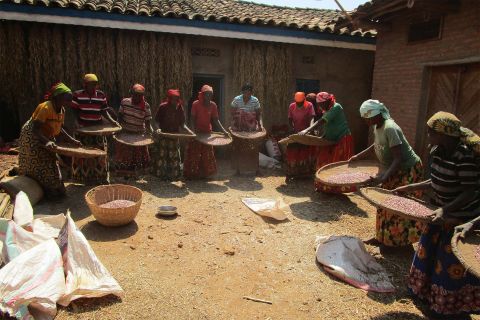Situation
Today almost a billion people in the world are under nourished: one in seven people are not fed enough to lead a healthy and active life. Hunger and malnutrition are, on a world scale, the number one risk to human health, their impact exceeds that of AIDS, malaria and tuberculosis combined.
In developing countries, about three quarters of under nourished people live in rural areas with low levels of income, principally in vulnerable agricultural areas. The paradox is that those who live in the country, close to arable land, are the most numerous to suffer from hunger. Amongst these peasant families, it is usually the women and children who suffer the most.
FH helps rural communities to produce more and better. Because of new varieties of cassava, beans, soya, sunflowers and other plants, farmers can reap harvests of better quality and in greater quantities. Due to the training they receive, members of farming groups supported by FH can also learn how to better cultivate their land and store their products. Groups often start off informally and then become cooperatives. In this way they integrate into the local economic network and can obtain bank loans that allow them to invest and develop their production.
Our agricultural projects are also environmental projects: in hilly areas, like Rwanda, Burundi and RDC Congo, trees are planted, terraces are built or anti erosion dykes are dug. All of these measures lead to diminished erosion, as a means of maintaining the precious humus on the surface and to build up an environment that lends itself to cultivation. Other agricultural projects are being run in Uganda and in Cambodia. They deal with rice growing. Often, these agricultural projects include cattle farming, or chickens, goats or pigs farming.
Agricultural development also seeks to reinforce community life and favour life together. With income being released, families can pay for school fees for their children and for their health care. This greatly helps reduce child mortality and malnutrition.
Projects
FH works with groups of farmers to help them achieve food security. This means being able to feed oneself adequately, being able to access food of sufficient quality in sufficient amount in other words knowing for sure that a meal will be available during any one day. FHs partners are farming groups that are particularly vulnerable to food insecurity.
» See all projects
The agricultural projects* of FH are centred on the development of skills in the areas of productivity and marketing, as well as the management of the environments of farming groups. They also favour food independence amongst the rural communities affected.
More specifically, the agricultural projects will, in general*, reflect the following goals:
- Allow farmers to have access to quality seeds (non-GMC) which they can multiply.
- Favour agro-forestry: plant trees that fertilise the soil. Restore fertility to fields by using organic fertilisers (manure, compost).
- Reduce erosion: by building radical or progressive terraces.
- Develop small livestock farming which also allows spreading manure on crops.
- Build storage infrastructures that guard against theft as well as against insects and other pests.
- Favour the transformation of agricultural produce and its marketing.
- Reinforce the capacity of farming groups in the following areas: bookkeeping, organisation, planning and farming techniques.
- Favour access to credit by building links between the producers and local micro-finance institutes, sometimes by providing a guarantee funds.
*Projects are prepared in a participatory manner by the local groups end FH staff. Projects will have common characteristics but will differ in detail one from another, as they are adapted to the local context which is determined by things such as the sloping of the land or the level of organisation of the group, etc.
Results
Families are getting out of malnutrition because of their involvement in agricultural cooperatives for farmers and their wives.
Since FH has been working to reinforce capacity of farming groups, more than 150 groups, spread through 5 African and Asian countries, have been helped and supported. This represents around 10,000 people.
Tangible reductions in malnutrition were achieved. Thus, in Burundi, in an area where food insecurity was rife, an evaluation done in 2011 showed that after a few years, the number of meals consumed daily had increased. Today, about 88% of the families benefit from 2 to 3 meals a day, whereas a large majority only had one meal beforehand, if any at all.
Within the groups supported by FH, improvements were also visible in the areas of agricultural productivity and the environment. Yields have improved in crops, sometimes by 50% and sometimes by even more than 100% in some cases. Also, due to improvements in the quality of the crops, sale prices have also gone up.




